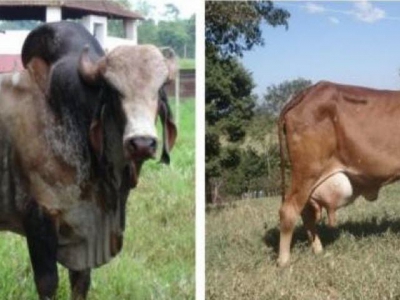Genes identified that could lead to beef cattle improvement

Researchers in Brazil identify 35 genes associated with reproduction, milk composition, growth, meat, carcass, health and body conformation traits in Gir cattle.
Researchers identify 35 genes associated with reproduction, milk composition, growth, meat and carcass, health or body conformation traits in Gir cattle (specimens from herds with selected traits for beef and milk production).
For decades, beef cattle improvement programs have focused on promoting the rapid growth of calves, but over time, the emphasis of many programs has shifted to other traits, such as meat tenderness or rib-eye muscle area.
Researchers at São Paulo State University (UNESP) in Brazil who are studying the genome of the Gir breed of Zebu cattle have identified 35 genes associated with reproduction, milk composition, growth, meat, carcass, health and body conformation traits. This identification is a key step toward the development of novel lines with traits desired by producers and consumers, UNESP said.
The group recently published results of the study in the journal PLOS ONE. The group is led by Josineudson Augusto II de Vasconcelos Silva, a professor at the university's Botucatu School of Agrarian & Veterinary Sciences. Researchers affiliated with the University of Georgia in the U.S. and with Brazilian animal science institutes located in Nova Odessa and Sertãozinho, both in São Paulo state, also took part. The research was supported by São Paulo Research Foundation - FAPESP.
The Gir breed originated in India and has been successfully introduced into the tropics. It is one of the main cattle breeds farmed in South American tropical countries, especially Brazil, UNESP said. However, the various populations have pronounced differences. Strong artificial selection in recent decades has increased the genetic differentiation among herds in different countries in the region.
In Brazil, Gir cattle are mainly farmed for milk today, but they were once an option for meat producers, who now prefer Nelore cattle.
To locate the genes associated with beef and dairy production in Gir cattle, the researchers analyzed the genotypes of animals from different populations, including a herd raised between 1976 and 2003 at the Sertãozinho Animal Science Institute.
During this period, the institute's scientists selected animals from the herd to develop traits associated with meat production, such as rapid yearling growth, UNESP said. As a result, calves born to cows in this herd became steadily larger. In 2003, however, the herd was sold in response to a change in preference among farmers, who opted to raise Gir for dairy rather than beef.
At that time, Brazil launched its Dairy Gir Genetic Improvement Program (PNMGL). Over time, selection for traits associated with milk production led to cows with steadily larger udders that produced increasing amounts of milk.
The genotyping exercise used hair samples collected in 2003 from 173 bulls, cows and yearlings belonging to a herd selected for beef production and from 273 animals belonging to the PNMGL herd, which was selected for dairy production and raised on five farms in Brazil's Minas Gerais and São Paulo states.
The researchers also recorded key life-cycle data, such as birth weight, preweaning and postweaning weights and slaughter weight.
"We selected a Gir group for beef and another for dairy. The difference in morphology was significant. The animals selected for beef had more muscle mass and were stronger, while cows selected for dairy had very large udders," Vasconcelos Silva said. "The results obtained are clear and consistent with the history of both populations. Because they were involved in different breeding programs, there was intentional segregation of their genes, leading to complete isolation and this significant genetic variation."
The genomes of the 173 animals selected for beef production were compared with the genomes of the 273 animals selected for dairy production with the aim of detecting the regions in which the respective genes were located, UNESP said.
"We found that 282 genes in the regions concerned could be considered signatures of selection in Gir beef and dairy herds. Of these, 35 were found to be associated with reproduction, milk composition, growth, meat and carcass, health or body conformation traits," Vasconcelos Silva said.
Larger herds
The FAPESP-funded investigation showed that traits associated with fertility, milk production, beef quality and growth were involved in the process of differentiation between the two populations, one selected for meat production and the other for milk production, UNESP said. Some of these 35 genes were already known to science. The rest are new discoveries.
The next steps will involve larger herds. The research group will genotype at least 2,000 animals to understand how the previously known genes are expressed and, more precisely, how they are associated with the traits investigated.
"We may perhaps discover that some genes are more abundantly expressed in Gir than Nelore, for example," Vasconcelos Silva said.
Another possibility will be a comparison of Gir genes with those of a European breed such as Angus, which is preferred by Brazilian steakhouses.
FAPESP is a public institution in Brazil with the mission of supporting scientific research in all fields of knowledge by awarding scholarships, fellowships and grants to investigators linked with higher education and research institutions in the state of São Paulo, Brazil.
Có thể bạn quan tâm
Phần mềm

Phối trộn thức ăn chăn nuôi

Pha dung dịch thủy canh

Định mức cho tôm ăn

Phối trộn phân bón NPK

Xác định tỷ lệ tôm sống

Chuyển đổi đơn vị phân bón

Xác định công suất sục khí

Chuyển đổi đơn vị tôm

Tính diện tích nhà kính

Tính thể tích ao hồ



 Cow's high selenium diets may boost protein transfer…
Cow's high selenium diets may boost protein transfer…  Managing heat in the desert
Managing heat in the desert